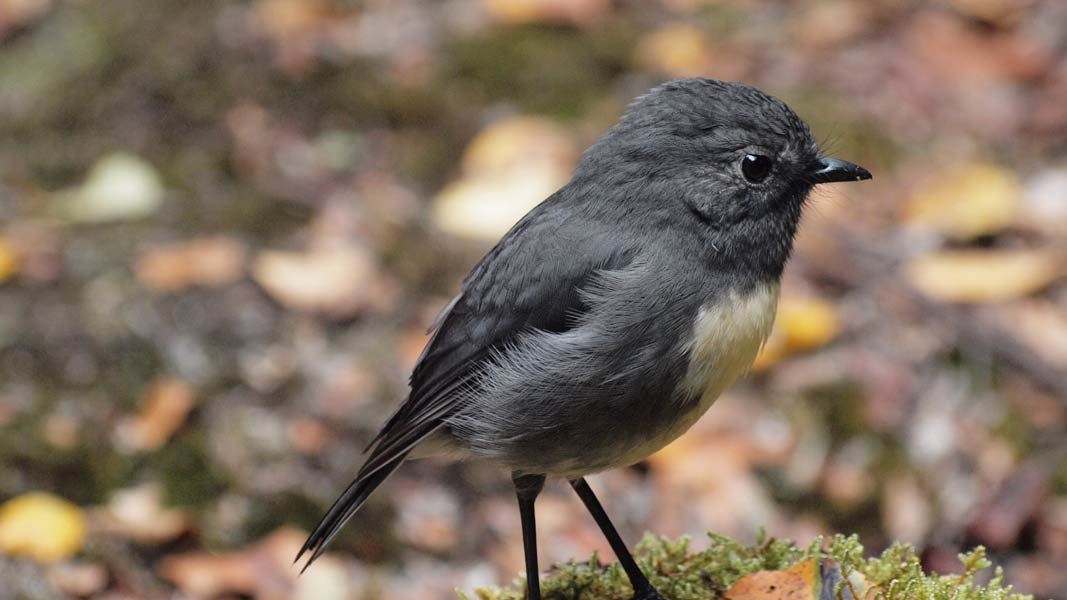New Zealand status: Endemic
Conservation status: At Risk–Declining
Found in: Forests with dense, even, canopies and ground covered with leaf litter
Threats: Habitat loss, predation
Sound recordings:
New Zealand robin/toutouwai song (MP3, 1,440K)
01:22 New Zealand robin song at Kowhai River, Kaikouras, Marlborough.
North Island robin/toutouwai song (MP3 1,553K)
01:38 – North Island robin song.
Species information: North Island robin, South Island robin on NZ Birds Online
Image gallery
Did you know?
To attract a female, bachelors will sing a song lasting up to 30 minutes!
New Zealand robin conservation
Different species/sub-species
When using the name New Zealand robin you may be referring to:
- North Island robin (Petroica longipes)
- South Island robin (Petroica australis australis)
- Stewart Island robin (Petroica australis rakiura)
They are all New Zealand robins although, strictly speaking, the North Island robin is a completely different species from the other two subspecies. New Zealand robins are also closely tied genetically with the black robin (Petroica traversi) in the Chatham Islands and also the tomtit.
New Zealand robins are relatively long-lived, for small forest birds. The average lifespan for the species is expected to be 4 to 5 years, although they may survive up to 17 years where intensive predator control is undertaken.
Predator control
Introduced predators, particular ships rats, possums, stoats and feral cats continue to impact robin populations. They take many eggs, nestlings and recent fledglings. In addition, because females carry out all incubation and chick-brooding duties, a significant proportion are killed at night by introduced predators.
Pest control work in areas where robins live, has not only improved the overall forest health, but also helped robin populations. It is only on predator-free islands, in predator-free fenced sanctuaries, or sites where introduced predators are controlled to low numbers that healthy populations of robins exist.
These flourishing populations have been used to help repopulate areas where robins may have died out due to predation.
Translocation
DOC has helped trusts and community groups to establish robins at several sites. This is partly to enable people interested in New Zealand’s birdlife to see and hear this interesting species. The robin's trusting nature makes it a favourite with people because they can get close to the bird unlike other native birds.
Since 1991, North Island robin populations have been established on several predator-free islands (Mokoia, Tiritiri Matangi, Tuhua, Matiu/Somes, Mana, Moturoa) and several mainland sites which are encircled by predator-proof fences (Karori Sanctuary, Bushy Park Reserve).
Monitoring
There are several characteristics of the robin’s nature that make it a very tractable species for monitoring:
- They can be caught by a variety of methods
- Have relatively long legs and so colour-bands can be readily seen
- Will approach researchers for a small food (mealworms) handout
- Their nests can be readily found and monitored without the birds abandoning them.
This has enabled the survival of individuals and nesting attempts to be monitored by DOC staff to determine the effectiveness of predator control operations.
Toutouwai - Robin's Return project
North Island robin/toutouwai have been returned to Moehau in the northern Coromandel Peninsula as part of the 'Toutouwai - Robin's Return' project. The aim was to create a self-sustaining population of North Island robin and return the bird to part of their former home.
You can help
Fence forest blocks to prevent them being grazed by stock. This will enhance their value to robins and other native fauna.
Control predators (possums, feral cats, rats and stoats) by trapping and poisoning. By controlling these predators to low numbers, robins can breed much more successfully than otherwise (70% compared to 20%). As a result, within the first year of such a pest control operation, the robin population often doubles in number, and most males are able to obtain a mate.
